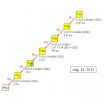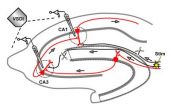(Press-News.org) Southfield, MI - - Understanding and evaluating art has widely been considered as a task meant for humans, until now. Computer scientists Lior Shamir and Jane Tarakhovsky of Lawrence Technological University in Michigan tackled the question "can machines understand art?" The results were very surprising. In fact, an algorithm has been developed that demonstrates computers are able to "understand" art in a fashion very similar to how art historians perform their analysis, mimicking the perception of expert art critiques.
In the experiment, published in the recent issue of ACM Journal on Computing and Cultural Heritage, the researchers used approximately1, 000 paintings of 34 well-known artists, and let the computer algorithm analyze the similarity between them based solely on the visual content of the paintings, and without any human guidance. Surprisingly, the computer provided a network of similarities between painters that is largely in agreement with the perception of art historians.
The analysis showed that the computer was clearly able to identify the differences between classical realism and modern artistic styles, and automatically separated the painters into two groups, 18 classical painters and 16 modern painters. Inside these two broad groups the computer identified sub-groups of painters that were part of the same artistic movements. For instance, the computer automatically placed the High Renaissance artists Raphael, Leonardo Da Vinci, and Michelangelo very close to each other. The Baroque painters Vermeer, Rubens and Rembrandt were also clustered together by the algorithm, showing that the computer automatically identified that these painters share similar artistic styles. The automatic computer analysis is in agreement with the view of art historians, who associate these three painters with the Baroque artistic movement. Similarly, the computer algorithm deduced that Gauguin and Cézanne, both considered post-impressionists, have similar artistic styles, and also identified similarities between the styles of Salvador Dali, Max Ernst, and Giorgio de Chirico, all are considered by art historians to be part of the surrealism school of art. Overall, the computer automatically produced an analysis that is in large agreement with the influential links between painters and artistic movements as defined by art historians and critiques.
While the average non-expert can normally make the broad differentiation between modern art and classical realism, they have difficulty telling the difference between closely related schools of art such as Early and High Renaissance or Mannerism and Romanticism. The experiment showed that machines can outperform untrained humans in the analysis of fine art.
The experiment was performed by computing from each painting 4,027 numerical image context descriptors -- numbers that reflect the content of the image such as texture, color and shapes in a quantitative fashion. This allows the computer to reflect very many aspects of the visual content, and use pattern recognition and statistical methods to detect complex patterns of similarities and dissimilarities between the artistic styles and then quantify these similarities.
INFORMATION:
Computers match humans in understanding art
2012-09-26
ELSE PRESS RELEASES FROM THIS DATE:
Coral hotspots found in deepwater canyons off northeast US coast
2012-09-26
For the first time in decades, researchers have conducted an extensive exploration for deep-sea corals and sponges in submarine canyons off the northeastern coast of the US. The survey revealed coral "hotspots," and found that a new coral habitat suitability model could help predict where corals are likely to occur. The model is being developed by the Northeast Fisheries Science Center (NEFSC) and the National Ocean Service's Biogeography Branch.
Among the canyons surveyed during the July 6-18 cruise aboard the NOAA Ship Henry B. Bigelow were Toms, Middle Toms, and Hendrickson ...
Study pinpoints epigenetic function of common cancer-causing protein – it's not what science thought
2012-09-26
Squamous cell carcinoma (SCC) is diagnosed in about 700,000 people in the United States every year. Commonly contributing to SCC is a protein called DNp63a – it goes abnormally high and the ability of a patient's body to kill cancer cells goes abnormally low. In many cases of SCC, it's just that simple. And science thought the function of DNp63a was simple, as well: the tumor suppressor gene p53 is responsible for recognizing and killing cancer cells, and in SCC, it's usually inactivated. It looked like high DNp63a repressed p53, made SCC.
A University of Colorado Cancer ...
The rich colors of a cosmic seagull
2012-09-26
Nebulae are among the most visually impressive objects in the night sky. They are interstellar clouds of dust, molecules, hydrogen, helium and other ionised gases where new stars are being born. Although they come in different shapes and colours many share a common characteristic: when observed for the first time, their odd and evocative shapes trigger astronomers' imaginations and lead to curious names. This dramatic region of star formation, which has acquired the nickname of the Seagull Nebula, is no exception.
This new image from the Wide Field Imager on the MPG/ESO ...
Search for element 113 concluded at last
2012-09-26
The most unambiguous data to date on the elusive 113th atomic element has been obtained by researchers at the RIKEN Nishina Center for Accelerator-based Science (RNC). A chain of six consecutive alpha decays, produced in experiments at the RIKEN Radioisotope Beam Factory (RIBF), conclusively identifies the element through connections to well-known daughter nuclides. The groundbreaking result, reported in the Journal of Physical Society of Japan, sets the stage for Japan to claim naming rights for the element.
The search for superheavy elements is a difficult and painstaking ...
Researchers uncover biochemical events needed to maintain erection
2012-09-26
For two decades, scientists have known the biochemical factors that trigger penile erection, but not what's needed to maintain one. Now an article by Johns Hopkins researchers, scheduled to be published this week by the Proceedings of the National Academy of Sciences (PNAS), uncovers the biochemical chain of events involved in that process. The information, they say, may lead to new therapies to help men who have erectile dysfunction.
"We've closed a gap in our knowledge," says Arthur Burnett, M.D., professor of urology at Johns Hopkins Medicine and the senior author ...
Moffitt Cancer Center researchers say smoking relapse prevention a healthy step for mothers, babies
2012-09-26
Researchers at Moffitt Cancer Center, concerned that women who quit smoking during their pregnancies often resume smoking after they deliver their baby, tested self-help interventions designed to prevent postpartum smoking relapse.
"We'd first like to see more women quit smoking when they become pregnant," said Thomas H. Brandon, Ph.D., senior member at Moffitt and chair of the Department of Health Outcomes and Behavior. "However, even among those who do quit, the majority return to smoking shortly after they give birth."
According to the researchers, nearly 50 percent ...
Severe hunger increases breast cancer risk in war survivors
2012-09-26
Jewish women who were severely exposed to hunger during World War Two were five times more likely to develop breast cancer than women who were mildly exposed, according to research in the October issue of IJCP, the International Journal of Clinical Practice.
The study also found that women who were up to seven-years-old during that period had a three times higher risk of developing breast cancer than women who were aged 14 years or over.
Sixty-five women diagnosed with breast cancer between 2005 and 2010 were compared with 200 controls without breast cancer. All ...
Slave rebellion is widespread in ants
2012-09-26
Ants that are held as slaves in nests of other ant species damage their oppressors through acts of sabotage. Ant researcher Professor Dr. Susanne Foitzik of Johannes Gutenberg University Mainz (JGU) in Germany first observed this "slave rebellion" phenomenon in 2009. According to the latest findings, however, this behavior now appears to be a widespread characteristic that is not limited to isolated occurrences. In fact, in three different populations in the U.S. states of West Virginia, New York, and Ohio, enslaved Temnothorax longispinosus workers have been observed to ...
Learning requires rhythmical activity of neurons
2012-09-26
This press release is available in German.
The hippocampus represents an important brain structure for learning. Scientists at the Max Planck Institute of Psychiatry in Munich discovered how it filters electrical neuronal signals through an input and output control, thus regulating learning and memory processes. Accordingly, effective signal transmission needs so-called theta-frequency impulses of the cerebral cortex. With a frequency of three to eight hertz, these impulses generate waves of electrical activity that propagate through the hippocampus. Impulses of a different ...
New AACP Practice Parameter on gay, lesbian, bisexual, and gender variant issues
2012-09-26
Washington D.C., September 26, 2012 – The American Academy of Child and Adolescent Psychiatry (AACAP) is proud to announce its new Practice Parameter on issues related to and affecting gay, lesbian, bisexual, and gender variant youth.
Gay, lesbian, bisexual, and gender variant children and adolescents face unique developmental challenges and stressors that can influence their mental health and wellbeing. Social issues such as stigma, bullying, and discrimination, and personal factors like internalized prejudice and feelings of being different are just a few of the concerns ...



